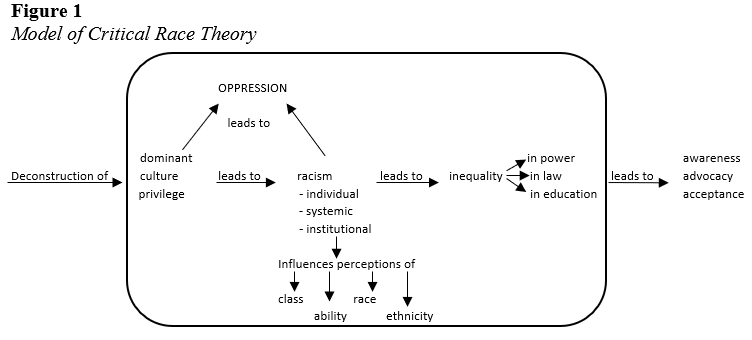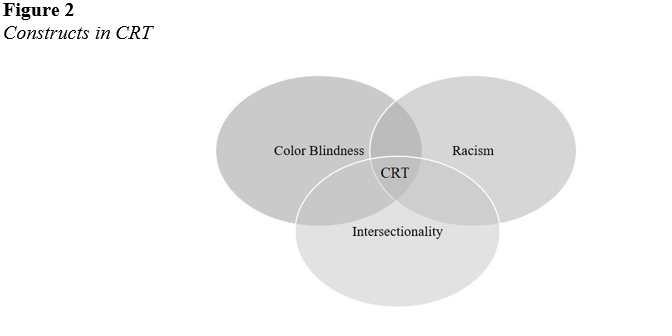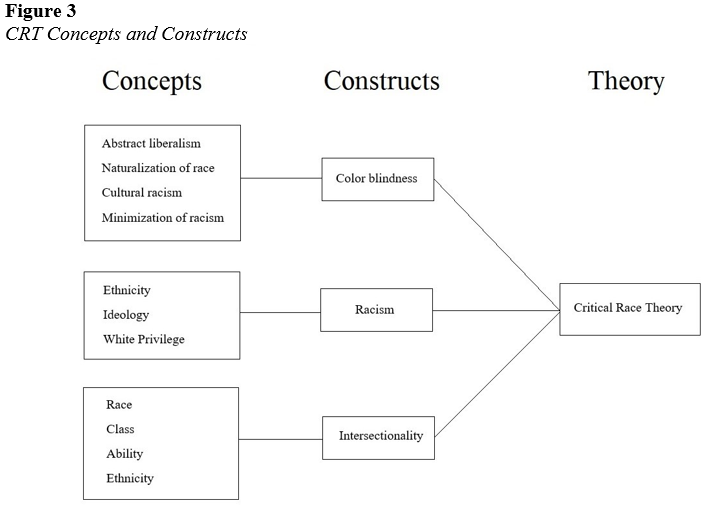Critical Race Theory
Sarah E. Movius
Critical Race Theory (CRT) deconstructs a dominant culture’s constructed view of race and explains how the construct is used to suppress people of color in society. Exploring the complexity of how society has been shaped by the dominant culture and analyzing the finding through the lens of race can lead to a deeper understanding of the oppression and suppression of people of color and lead to advocacy. There are two precursors to CRT, Critical Theory (in general) and Critical Legal Theory. While both theories have similar influences, each theory analyzes race differently and adds to how work by philosophers such as Karl Marx and Max Horkheimer is understood (Crossman, 2019; Cornell Legal School, n.d.).
It is important to understand how critical theories differ from non-critical theories. Non-critical theories focus on trying to understand or explain a particular aspect of an individual or society, whereas critical theories focus on critiquing and modifying society as a whole. According to Crossman (2019), “A critical theory must do two important things: It must account for society within a historical context, and it should seek to offer a robust and holistic critique by incorporating insights from all social sciences” (n.p.). For example, Critical Legal Theory is grounded in an understanding that “the law supports a power dynamic which favors the historically privileged and disadvantages the historically underprivileged” (Cornell, n.d., n.p.); this theory allows for direct analysis of the oppression and discrimination against underprivileged people and people of color present in the current legal system. With roots in the civil rights movement and Vietnam war, Critical Legal Theory emerged in an era rife with activism and controversy through scholars ready to analyze the justice system in America. It urges the legal fields to pay more attention to the social context of the law and to uphold the integrity of the legal system equitably. These theories have contributed a variety of concepts to CRT and helped to focus how CRT developed as a theory.
Previous Studies
Research that uses CRT delves into many different avenues of investigation; the ways that white dominant culture impacts marginalized populations are complex and can have far-reaching consequences in places that may not be obvious. For example, Wolf-Meyer (2019) analyzes how the dominant culture is being promoted and perpetuated in apocalyptic and fictitious texts. Focusing on how race is represented in the sci-fi dystopian classic movie RoboCop (Schmidt & Verhoeven, 1987), the researcher points out the overwhelming lack of diversity as well as the ideology of white superiority. In this story, the only way to save the city of Detroit is to create an android, RoboCop, that “…has the soul of a white man who can recall a time when Detroit wasn’t the crime-ridden dump it has become, waiting to be gentrified into Delta City” (Wolf-Meyer, 2019, p.32). This message is further reinforced by RoboCop being the only police officer able to fight corruption, gang violence, and drug dealers to bring peace to Detroit (The Numbers, n.d.). RoboCop is a “White savior” and the protector of Detroit; however, in real life, nearly two-thirds of the citizens of Detroit are Black. In the film, black actors have roles as henchmen or characters of little to no importance (Wolf-Meyer, 2019). This film implies that, in the future, there will be little place for any race other than White.
In another study, Delgado and Stefancic (2001) explore how CRT applies to current society. They analyze “some of the internal struggles that are playing out within the group and examine a few topics, such as class, poverty, the wealth and income gaps, crime, campus climate, affirmative action, immigration, and voting rights, that are very much on the country’s front burner” (Delgado & Stefanic, 2001, p.113). Since the nineties, a series of policy initiatives funded by right-wing conservatives have called for removing social programs and public funding, cutting bilingual education, abolishing affirmative action, deregulating hate speech, ending welfare, and revamping measures that support the increase of minorities in the political arena (Delgado & Stefanic, 2001). The measures are designed to perpetuate the already skewed status quo and to further segregate people of color from achieving equity by removing programs that help to alleviate inequalities within the exclusive systems that are dominated by White interests.
Further, Christian et al. (2019) examined the relevance of CRT for sociological theory and empirical research Throughout their research, they explored how CRT explains the long-standing continuity of racial inequality and how racism and white supremacy are reproduced through more than cultural inequalities. They also analyze how the use of CRT has systematically give a voice to people of color and how that voice is becoming one of resistance that is challenging racism and oppression in society. When analyzing race and white supremacy, Christian et al. (2019) use CRT to highlight the different pieces of race and racism in conjunction with cultural inequalities; their critical analysis dissects social and cultural inequalities to explain how color blindness, intersectionality, and race impact our social system and how they are used to debilitate people of color. Through the lens of CRT, Christian et al. push scholars past traditional questions about racism and encourage them to investigate the mechanisms that systemically reproduce inequity in American society.
In other words, CRT is based on the idea that, to understand the current system of oppression and inequality institutionalized in American society, it is necessary to analyze the roots of racism and be transparent when discussing racial domination. In America’s dominant culture, the reality based on CRT is that “whites created racial categories, imbued meaning and structural properties to each category, and racialized modern social relations, institutions, and knowledge” (Christian et al., 2019, p. 1735). CRT scholars believe that by critical analysis and dissection of the dominant culture, knowledge can be gained about how to counter White hegemonic dominance. Christian et al. end their article with asking fellow scholars and researchers to become part of a resistance that is fighting for equity and equality for people of color and to reveal how institutionalized privileges, societal norms, and hegemonic hierarchies are perpetuating systematic racism and oppression to silence people of color.
Model of Critical Race Theory
One possible model for CRT is presented in Figure 1. By using CRT to deconstruct the individual concepts that comprise it, the causes of racism and racial oppression can be understood and advocated against.

Precursors
As noted above, Critical Theory and Critical Legal Theory ground the concepts, constructs, and proposition of CRT.
Concepts and Constructs
Many different concepts comprise the bigger constructs that form the proposition of CRT. Three of the primary constructs that have emerged and define crucial elements of CRT include color blindness, racism, and intersectionality. No one concept or construct is more important than the others; each weighs in with its complex structure that supports CRT. Figure 2 illustrates the constructs within CRT. These three central constructs are explained below.

Color Blindness
The ideology behind color blindness suggests that, to end discrimination based on race, all people must be treated as equal regardless of their race, ethnicity, or culture. This ideal of equality is centered around the words of Martin Luther King Jr.’s “I Had a Dream” speech (1963). Specifically, as King stated, a person should be judged by the content of his or her character, not by the color of his or her skin. While the ideology behind color blindness is derived from the desire to focus on people’s commonalities and shared humanity, it falls short in producing equity and, in the end, operates as a form of racism. Four key concepts are promoted by color blindness. The first concept is abstract liberalism. Abstract liberalism involves using ideas associated with political liberalism (e.g., force should not be used to achieve social policy) and economic liberalism (e.g., choice, individualism) in an abstract manner to explain racial matters (Bonilla-Silva, 2013). While the idea behind abstract liberalism sounds like a move in the right direction, it actually undermines affirmative action and ignores existing racial inequality.
The second concept is the naturalization of race. Naturalization of race is founded on the idea that “like gravitates to like” on a biological level and thereby reinforces the segregation of groups via one’s race (Bonilla-Silva, 2013; Williams, 2011; Wingfield, 2015; Wingfield & Williams, 2011, 2015). Naturalization of race therefore says that each race should only associate with people of the same race, perpetuating the notion that segregation is natural and needs to be applied for the greater good of all.
The third concept that makes us the construct of color blindness is cultural racism. Cultural racism relies on arguments based solely on culturally-based biases and fallacies; the common statements that “all Asians are good at math” and “White men can’t jump” provide examples of such fallacies and biases. Beliefs like these promote the idea that peoples’ race defines their abilities and limitations as a human being (Bonilla-Silva, 2013).
The fourth concept in this construct is the minimization of racism, suggests that discrimination no longer affects any aspect of a minority’s life when there is evidence to suggest the direct opposite. Racially motivated murders of African Americans and the slow response from the federal government to help predominantly black neighborhoods after Hurricane Katrina made landfall offer examples. When attention is brought to these concerns, minorities are often accused of being hypersensitive or playing the “race card,” leaving the reality of the situation discarded because racial discrimination no longer exists (Bonilla-Silva, 2013).
Racism
The basic definition of racism is “prejudice, discrimination, or antagonism directed against someone of a different race based on the belief that one’s race is superior” (Merriam-Webster, n.d., n.p.). The construct of racism within CRT consists of three main concepts: ethnicity, ideology, and White privilege.
In part, the ideology of racism can be tied to the First Amendment. Through the lens of CRT, it can be understood that instead of helping to achieve equality, it perpetuates the status quo due to protecting hate speech. Demaske, (n.d.) states that, “No one legal definition exists for hate speech, but it generally refers to abusive language specifically attacking a person or persons based on their race, color, religion, ethnic group, gender, or sexual orientation and is seen as freedom of speech” (n.p.). This ties into the belief that one person’s right to free speech is more legitimate than another’s.
When referring to White privilege, the simplest definition is that if a person is White, they have an inherent advantage over all other non-White races. White privilege consists of many different components that work together to continue to influence systemic decisions that promote the agenda of the dominant culture without concern for the inequalities that are present (Bonilla-Silva, 2013).
Intersectionality
The construct of intersectionality draws together the interconnectedness of race, class, gender, and sexuality in a person’s everyday lived experiences (Bell, 2018). The interconnectedness could be used as a way to discriminate against a person based on being a part of particular groups, which defines a person’s racial privilege. Within intersectionality are four main concepts: race, class, ability, and ethnicity. These concepts are a way to create social categorization, which can be used to establish an overlapping and interdependent system of multiple forms of discrimination and to create a further divide between all others and the dominant culture (Crichlow, 2015). Another way to look at the concepts and constructs that comprise CRT is shown in Figure 3.

Proposition
CRT proposes that deconstructing the current system of oppression based on color blindness, racism, and intersectionality can uncover issues of oppression and lead to advocacy, awareness, and acceptance among people.
Using the Model
There are many ways that the model of CRT can be used by teachers, students, and researchers for personal or professional reasons. For example, CRT can be a helpful tool for analyzing policy issues such as school funding, segregation, language policies, discipline policies, and testing and accountability policies (Groves-Price, n.d.). The model can be used by students to challenge the conventional legal strategies that are used to make social and economic decisions and to change the legal approach to take into consideration the nexus of race in American life (Demaske, n.d.). The CRT model can also be used as a foundation to assist teachers to “communicate understanding and reassurance to needy souls trapped in a hostile world” (Bell, 1995, n.p.). Further, the model can support researchers “to help analyze the experiences of historically underrepresented populations across the k-20 education [system]” (Ledesma & Calderón, 2015, p. 206). In classrooms, CRT can be used as part of an instructional strategy that develops a deeper understanding of how race is portrayed in America and within our professional and personal spheres and how those spheres impact our understanding of culture in America.
Conclusion
The deconstruction of systems that are currently in place to suppress people of color and promote dominant culture interests can play a role in achieving equal representation of people of color in all aspects of society and culture. Understanding the basic concepts, constructs, and proposition of CRT can assist in this endeavor.
References
Bonilla-Silva, E. (2013). The central frames of color-blind racism: Color-blind racism and the persistence of racial inequality in the United States. Rowman & Littlefield Publishers, Lanham.
Christian, M., Seamster, L., & Ray, V. (2019). New directions in Critical Race Theory and sociology: Racism, white supremacy, and resistance. American Behavioral Scientist, 63(13), 1731–1740.
Cornell Law School. (2020). Critical legal theory. https://www.law.cornell.edu/ wex/critical_legal_theory
Crichlow, W. (2015). Critical race theory: A strategy for framing discussions around social justice and democratic education. Higher Education in Transformation Conference, Dublin, Ireland, pp.187-201.
Crossman, A. (2019). Understanding Critical Theory. Thought Co. https://www.thoughtco.com/critical-theory-3026623
Delgado, R., Stefanic, J., & Harris, A. (2020). Critical Race Theory today. In Critical Race Theory: An Introduction (pp. 101-128). New York; London: NYU Press. http://www.jstor.org/stable/j.ctt9qg26k.11
Demaske, C. (n.d). Critical race theory. The First Amendment Encyclopedia. Retrieved from https://www.mtsu.edu/first-amendment/article/1254/critical-race-theory
Groves Price, P. (2020). Critical Race Theory. Oxford Research Encyclopedia of Education. https://oxfordre.com/education/view/10.1093/acrefore/9780190264093.001.0001/acrefore-9780190264093-e-1.
King, M. L. (1963). I Have a Dream. Address delivered at the March on Washington for jobs and freedom. Retrieved from https://kinginstitute.stanford.edu/king-papers/documents/i-have-dream-address-delivered-march-washington-jobs-and-freedom
Ledesma, M. C., Calderón, D., & Parker, L. (2015). Critical Race Theory in education: A Review of past literature and a look to the future. Qualitative Inquiry, 21(3), 206–222.
Merriam-Webster (n.d.). Racism. In Merriam-Webster.com dictionary. https://www.merriam-webster.com/dictionary/racism
Numbers, The (n.d.). Robocop. https://www.the-numbers.com/movie/RoboCop-(1987)#tab=summary
Schmidt, A. (Producer), & Verhoeven, P. (Director). (1987). RoboCop [Motion Picture]. United States: Orion Pictures.
Williams, M. T. (2011). Colorblind ideology is a form of racism: A colorblind approach allows us to deny uncomfortable cultural differences. Psychology Today. https://www. psychologytoday.com/us/blog/culturally-speaking/201112/colorblind-ideology-is-form-racism
Wingfield, A. H. (2015). Color-blindness is counterproductive. The Atlantic. https://www.theatlantic.com/politics/archive/2015/09/color-blindness-is-counterproductive/405037/
Wolf-Meyer, M. (2019). White futures and visceral presents: Robocop and P-Funk. In Theory for the World to Come: Speculative Fiction and Apocalyptic Anthropology (pp. 31-40). Minneapolis; London: University of Minnesota Press.
